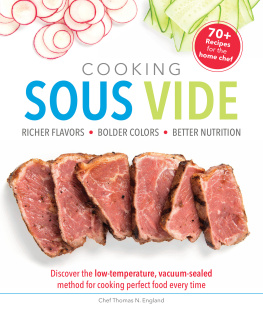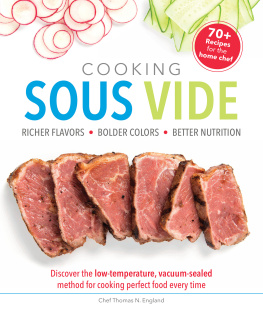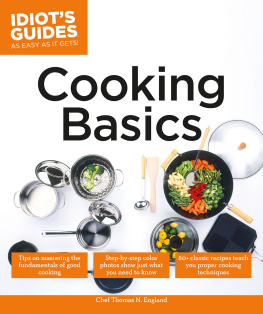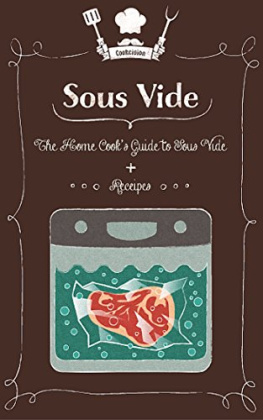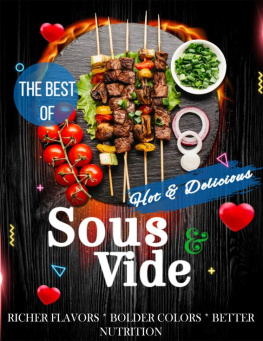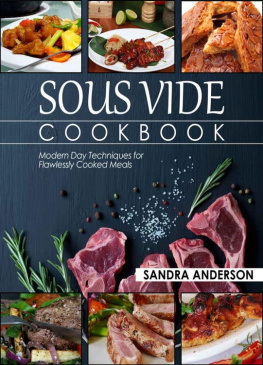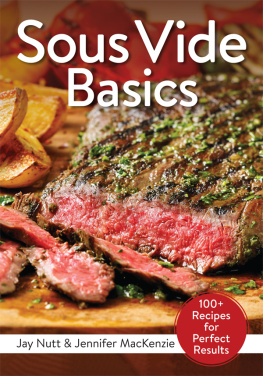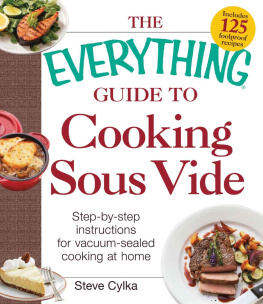Contents
Guide
COOKING
SOUS VIDE
RICHER FLAVORS BOLDER COLORS BETTER NUTRITION
Chef Thomas N. England

Publisher: Mike Sanders
Associate Publisher: Billy Fields
Senior Acquisitions Editor: Brook Farling
Development Editor: Kayla Dugger
Cover and Book Designer: Rebecca Batchelor
Photographer: Daniel Showalter
Food Stylist: Allison Douglass
Recipe Tester: Geoff Kelty
Prepress Technician: Ayanna Lacey
Proofreader: Amy Borrelli
Indexer: Celia McCoy
PRODUCTION, LONDON
Digital Producer: Alex Valizadeh
Senior Digital Producer: Miguel Cunha
DIGITAL OPERATIONS, DELHI
Head of Digital Operations: Manjari Hooda
Producer: Rahul Kumar
Assistant Editor: Etika Kapil
Operations Assistant: Tauhid Nasir
First American Edition, 2016 Published in the United States by DK Publishing 6081 E. 82nd Street, Indianapolis, Indiana 46250
Copyright 2016 Dorling Kindersley Limited
A Penguin Random House Company
16 17 18 19 10 9 8 7 6 5 4 3 2 1
001-295094-October/2016
All rights reserved.
Without limiting the rights under the copyright reserved above, no part of this publication may be reproduced, stored in or introduced into a retrieval system, or transmitted, in any form, or by any means (electronic, mechanical, photocopying, recording, or otherwise), without the prior written permission of the copyright owner.
Published in the United States by Dorling Kindersley Limited.
IDIOTS GUIDES and Design are trademarks of Penguin Random House LLC
eISBN: 9781465454164
Library of Congress Catalog Card Number: 2016935495
Note : This publication contains the opinions and ideas of its author. It is intended to provide helpful and informative material on the subject matter covered. It is sold with the understanding that the author and publisher are not engaged in rendering professional services in the book. If the reader requires personal assistance or advice, a competent professional should be consulted.
Trademarks : All terms mentioned in this book that are known to be or are suspected of being trademarks or service marks have been appropriately capitalized. Alpha Books, DK, and Penguin Random House LLC cannot attest to the accuracy of this information. Use of a term in this book should not be regarded as affecting the validity of any trademark or service mark.
DK books are available at special discounts when purchased in bulk for sales promotions, premiums, fund-raising, or educational use. For details, contact: DK Publishing Special Markets, 345 Hudson Street, New York, New York 10014 or .
Printed and bound in the United States
idiotsguides.com
Introduction to Sous Vide
WHAT IS sous vide?
Sous vide is a French term that translates to under vacuum. The sous vide process involves sealing food in a bag and cooking it in a temperature-controlled water bath.
Cooking Under Vacuum
Originally referring to the process of vacuum sealing food in order to extend its shelf life, sous vide became known as a cooking process in the 1940s. At that time, people began experimenting with placing vacuum-sealed food in a pot of boiling water to heat it.
This rudimentary process wasnt refined until the 1970s, when a European scientist tested water temperatures in relation to sealed packages of food being cooked. His discoveries led to the adoption of sous vide as a tool to cook gourmet foods.
However, it really wasnt until 2000 that chefs in the United States started to understand and utilize the technique. By then, immersion circulators could heat water to exact temperatures. Thus, sous vide cooking became much more controlled and attainable.
How Sous Vide Is Different
Unlike traditional methods of cooking, sous vide cooks food evenly and at a lower temperature, leading to a better finished product.
Normally, foods are placed onto a heat source thats much hotter than the ideal temperature of the final cooked food. For instance, a piece of filet mignon is often sauted at a temperature between 300F and 500F (149C and 260C); however, the desired internal temperature is 135F (57C) for medium-rare steak. This results in a piece of meat that varies from very well done near the outside to medium-rare in the middle. With sous vide cooking, the filet mignon can be seasoned, put into a bag, and cooked in a water bath set to exactly 135F (57C). In just a few minutes, the whole steak is exactly medium-rare; it can then be put in a very hot saut pan for a few seconds to gain a flavorful brown exterior.
The sous vide technique also sets itself apart when it comes to cooking tougher cuts of meat. Normally, tough cuts are braised at a high temperature in order for the connective tissue to melt. For instance, a tough meat may be braised in a flavorful liquid in a 250F (121C) oven for 3 hours. If its cooked at too hot of a temperature though, the moisture literally boils out of the meat. With sous vide, the seasoned meat can be sealed in a plastic bag and placed in a water bath set at a much lower temperature. Because connective tissue readily melts at 150F (66C), you get a juicier slice of meat than if you braised it.
What sets sous vide apart from other methods is its ability to evenly cook any food.
Why Cook Sous Vide?
Beyond cooking foods evenly and at the perfect temperature, sous vide helps seal in flavor and nutrition. For instance, when making soup, youre likely familiar with how the smells of the broth waft through the air. While this helps build the feeling of hunger, it also means the smells in the air are no longer in the soup. Sous vide makes up for the loss of those delicious smells by sealing them into the bag, resulting in food that truly bursts with a multitude of flavors.
When it comes to nutrition, you can use sous vide to preserve the nutrients in your food, as it takes into account the different temperatures at which food still maintains them. So you dont have to rely on outdated cooking methods that can rob foods of nutrients. Instead, you can cook your food at the ideal temperature and end up with foods that yield the best nutrition, because the nutrients arent lost to less efficient cooking methods. For instance, you can cook green beans sous vide at just the right temperature so the bright green colors develop and the chlorophylls release their nutrients.
Based on these benefits, its easy to see why sous vide cooking is becoming popular in homes everywhere.
HOW DOES SOUS VIDE work?
The sous vide process differs from traditional cooking by using water instead of air to transfer heat, allowing you to set more precise cook times and letting you cook to an exact temperature. This method results in food thats perfectly cooked.
 Without Oxygen
Without Oxygen
Oxygen is the enemy of freshness. When heating up foods using conventional cooking methods, the food molecules expand and allow oxygen to enter as they heat up (a process known as oxidation). Oxidation causes foods to lose their flavor and color. On the other hand, sous vide packaging removes oxygen from the equation by requiring you to seal foods in plastic bags or jars. This prevents oxidation, keeping your foods bright and flavorful.

